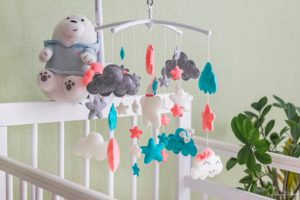
In this guide, we’ll explore practical tips and creative ideas to help you create a nursery that is both organized and inviting for your little one.
Nursery Organization: Tips for Creating a Functional Space:
Declutter and Prioritize:
Begin by decluttering the nursery and prioritizing essential items. Donate or store items that your baby has outgrown or no longer needs to free up space for necessities.
Invest in Storage Solutions:
Utilize a variety of storage solutions such as bins, baskets, shelves, and drawer organizers to keep items neatly organized and easily accessible. Consider investing in furniture pieces with built-in storage, such as cribs with under-crib drawers or changing tables with shelves.
Create Zones:
Divide the nursery into distinct zones based on functionality, such as sleeping, feeding, changing, and play areas. This helps establish clear boundaries and makes it easier to find and store items related to each activity.
Label Everything:
Label bins, baskets, and drawers to help you quickly locate items and maintain organization. Clear, adhesive labels or chalkboard labels are practical options that can be easily updated as your baby’s needs evolve.
Utilize Vertical Space:
Make use of vertical wall space by installing shelves, hooks, or hanging organizers. This allows you to maximize storage without taking up valuable floor space and keeps frequently used items within arm’s reach.
Streamline Diaper Changing Station:
Keep diaper changing essentials organized and easily accessible by setting up a dedicated changing station. Stock diapers, wipes, creams, and diapers in a caddy or organizer near the changing table for quick and convenient diaper changes.
Establish a Clothing System:
Organize baby clothes by size, season, or type using drawer dividers or hanging organizers. This makes it easier to find and retrieve outfits while ensuring that your baby’s wardrobe remains tidy and manageable.
Rotate Toys and Books:
Rotate toys and books regularly to keep your baby engaged and prevent clutter. Store toys and books in baskets or bins, and switch them out periodically to maintain novelty and interest.
Opt for Multi-Functional Furniture:
Choose furniture pieces that serve multiple purposes, such as a convertible crib that transitions into a toddler bed or a dresser with a changing table top. This helps maximize space and functionality in the nursery.
Keep Safety in Mind:
Ensure that all furniture and storage solutions are securely anchored to the wall to prevent tipping hazards. Use childproofing measures such as safety latches on drawers and cabinets to keep curious little hands safe.
Personalize the Space:
Add personal touches to the nursery with wall art, decals, or framed photos that reflect your baby’s personality and create a nurturing environment. Incorporate soft textiles, plush rugs, and cozy seating to make the space inviting and comfortable.
Maintain Regular Maintenance:
Schedule regular maintenance sessions to declutter, clean, and reorganize the nursery as needed. This helps prevent accumulation of unnecessary items and ensures that the space remains functional and efficient.
A well-organized nursery is essential for creating a nurturing and comfortable environment for your baby. By implementing these tips for nursery organization, you can optimize space, streamline daily routines, and create a functional space that grows with your little one. With thoughtful planning and creative solutions, you can design a nursery that is not only practical and efficient but also reflects your unique style and preferences.